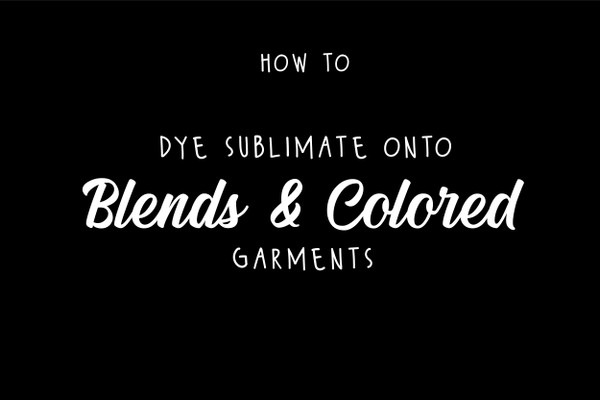Updated 4/27/21
Did you know that you can do Dye Sublimation transfer printing on garments other than white 100% polyester? Yes, you can use colored garments and even garments that are blends of materials!
We know many people are told that only white 100% polyester garments work with dye sublimation. White 100% does work best for producing the most vibrant and durable colors; however, there are so many other possibilities!
In this blog, we’re going to show you how we did dye sublimation printing on various t-shirts so that you can see the difference in how they turn out. We even threw some t-shirts in the wash to see how they hold up. Let’s get started!
Choosing a Dye Sublimation Printer
Before we dive into the main details of the blog, we want to quickly discuss what dye sublimation printer we think works best. The Sawgrass Virtuoso SG500 and SG1000 are, in our opinion, the best desktop dye sublimation printers on the market. We see many people wanting to use their inkjet printers, such as the Epson Workforce printers, by substituting the inkjet inks for sublimation inks. These can work if you use them correctly; however, these printers are not specifically designed for dye sublimation and leave room for (more) errors to occur.
On the other hand, the Sawgrass Virtuoso SG500 and SG1000 printers are specifically designed for dye sublimation. Overall, they are going to be much easier to use, produce more consistency in your printing, and even produce a better image!
Now the next question is, do you choose the SG500 or the SG1000? To keep it brief, the SG500 is great for printing transfers to press onto blanks such as luggage tags, coasters, can koozies, and Christmas ornaments. The SG1000 is much more preferable for dye sublimation printing of transfers to press onto clothing & apparel because of its larger size.
For more information on the Sawgrass Virtuoso SG500 vs. SG1000 Dye Sublimation printers, check out our YouTube video:
To keep everything consistent, for the purpose of this blog we used the same exact transfer for every shirt. We also pressed all shirts at 385°F for 40 seconds.
100% Polyester T-Shirts
First, we pressed 100% polyester t-shirts in white, Columbia blue and dark grey, all using the same dye sublimation image.
After you wash these shirts, the colors stay the same. You are never going to have any fading when using 100% polyester.
However, you are going to have a different contrast of color coming through the image on the pressed shirt. Dye sublimation printing will always take on the color of the substrate you’re pressing on.

The colors on the white shirt are super vibrant. Whereas on the dark grey shirt, the dye sublimation transfer heavily took on the color of the t-shirt. The darker the garment, the less vibrant the pressed-image will be. That being said, using a black garment is virtually impossible because you won’t be able to see any of the colors of the transfer through the black.
75% Polyester T-Shirts
Next, we pressed some nice white and heather grey tri-blend t-shirts that we got from Heat Transfer Clothing. These tri-blends are made up of 75% polyester, 13% cotton and 12% rayon.
As you can see, now that we have a lower polyester content of 75%, the initial pressed-image is slightly less vibrant than it is with 100% polyester. And then after washing it, there will be a little additional fading to the dye sublimation transfer.

You can see here that on the heather grey shirt, the pressed-image really took on the finish of the shirt. It’s still a great look, however white is always going to be the most vibrant once again.

50% Polyester T-Shirts
Lastly, we pressed some even softer tri-blend t-shirts that we got from Heat Transfer Clothing. These white and aqua blue shirts are made up of 50% polyester, 25% cotton and 25% rayon.
Now that the polyester content within these shirts is only 50%, you can see that the initial pressed-image is slightly more faded looking than the 75% polyester shirts. But don’t get used to that look, because even more fading takes place upon washing the shirt. Because more fading takes place, the transfer is going to take on more of the color of the shirt as shown on the aqua blue shirt.

You end up with a really unique vintage or washed-out looking shirt! It almost appears as if the shirt has already been broken in!

Pricing
Let’s briefly talk about pricing. Tri-blend t-shirts are nicer garments than your plain 100% polyester. They are going to feel softer, and offer a variety of fits and colors. So if you decide to do dye sublimation transfer printing on one of these nicer garments, make sure you are factoring in the added-value of the garment you are using. If you are running a business, don’t be afraid to increase your prices a little to reflect the use of premium clothing!
Summary - What shirt is best to use?
So now that we’ve shown you what 100%, 75%, and 50% polyester t-shirts looks like when doing dye sublimation printing and briefly discussed pricing, what type of shirt is the best to use? The answer to that question is dependent on your preference!
The lower polyester content there is, the more fading of the transfer will occur; however, the fading can create a really unique look that many people may actually want! We also showed you that colored t-shirts will create a less-vibrant image. However, once again this can create a unique look that may be in demand. We encourage you to explore using more than simple white 100% polyester garments with your dye sublimation printing. We are certain that this will help you expand your offerings and appeal to more customer demands.
Learn more by watching our YouTube video on How to do Dye Sublimation Printing of Blends (Mixed), Colored T-Shirts & Clothing:

